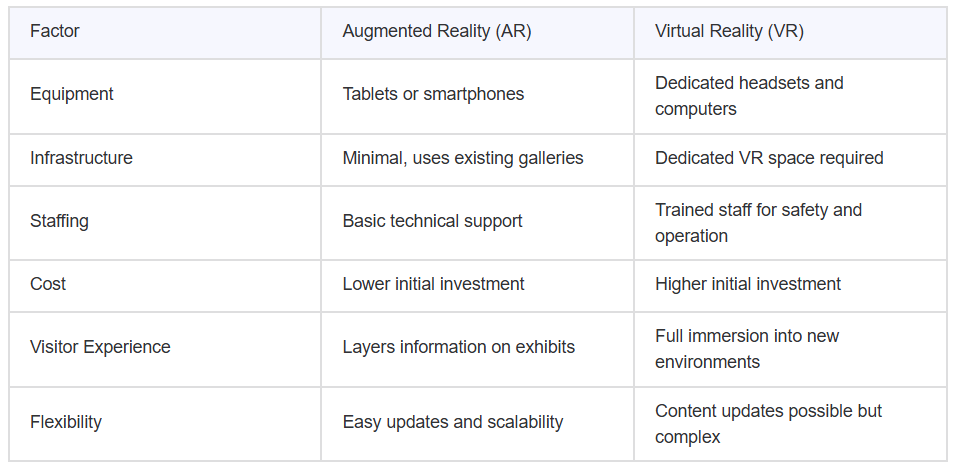Augmented Reality vs Virtual Reality in Museums: Which Technology Delivers More Impact? (Part 2)
Understanding the capabilities and constraints of augmented reality vs virtual reality represents only the first step in adopting immersive technology. The more challenging task lies in translating this knowledge into actionable decisions that serve your institution's unique context. Museum leaders must navigate complex considerations around budget allocation, staff capacity, audience expectations, and long-term sustainability while ensuring that technology choices advance educational missions rather than simply following trends.
This second installment provides practical frameworks for evaluating augmented reality vs virtual reality options, helping institutions move from theoretical understanding to confident implementation. Whether you operate a small historical society or a major science center, the decision-making criteria outlined here will help you identify which technology aligns best with your resources, audiences, and goals.
Recap: Key Insights from Part 1
In Part 1, we explored how augmented reality and virtual reality function within museum environments and examined their distinct advantages and limitations. Here's a quick summary of the core differences:
Augmented Reality overlays digital content onto physical exhibits, allowing visitors to access enhanced information through smartphones, tablets, or AR glasses. This approach maintains direct engagement with authentic artifacts while adding interpretive layers. AR offers lower implementation costs, easier integration into existing galleries, and minimal ongoing supervision requirements. However, it depends on adequate lighting, requires visitors to divide attention between devices and objects, and may create accessibility barriers for those without compatible technology.
Virtual Reality replaces physical surroundings entirely, transporting visitors into fully simulated environments through dedicated headsets. VR creates powerful emotional connections and enables experiences impossible with traditional exhibits. While it demands significant investment in equipment, dedicated spaces, and trained staff, VR generates strong visitor satisfaction, attracts younger demographics, and creates memorable signature experiences that distinguish institutions from competitors.
Comparative Overview: AR vs VR in Museums
Criteria for Choosing AR or VR in Museums
Making informed technology choices requires systematic evaluation across multiple dimensions. The following criteria provide a structured approach to assessing which immersive technology serves your institution most effectively.
Define Goals Clearly
Clarifying objectives helps determine whether AR or VR best meets your museum’s mission. AR is ideal for enhancing existing collections with interpretive layers. VR excels at transporting audiences into entirely new environments, providing impactful immersive engagement.
Assess Budget, Staffing, and Space
Financial resources represent the most tangible constraint, but comprehensive assessment must extend beyond initial acquisition costs to include ongoing operational expenses. AR projects typically require investments in software development, device management systems, and periodic content updates. While these costs remain manageable for most institutions, they accumulate over time and require dedicated budget lines.
VR installations demand substantial upfront investment in headsets and appropriate spaces. Additionally, budget for equipment replacement cycles (typically every 3-5 years as technology advances), software licensing, content development, and potentially increased insurance costs.
Consider Platform Flexibility
Decision-makers should evaluate how adaptable each platform is for future needs. AR experiences are easily updated, while VR allows rotating, cinematic content. A strategic combination of both can create complementary experiences for visitors.
Align With Audience and Outcomes
Understanding visitor demographics and learning objectives guides technology choice. Clear evaluation criteria, including costs, accessibility, and long-term goals, support purposeful adoption. Effective use of augmented reality vs virtual reality maximizes educational impact and visitor engagement.
Bringing Immersive Learning to Life
The strategic frameworks and comparative analyses outlined above provide essential decision-making tools, but they cannot fully capture the transformative power of well-executed immersive experiences. When augmented reality vs virtual reality technologies align with institutional missions and visitor needs, they transcend their technical specifications to become powerful storytelling platforms that make learning unforgettable.
Both AR and VR can enhance interpretation, deepen engagement, and attract new audiences when thoughtfully implemented. The choice between them depends less on inherent technological superiority and more on strategic fit with your museum's specific context, capacity, and educational objectives. Success comes not from adopting the newest technology but from selecting solutions that amplify your institution's unique strengths and serve your community's actual needs.
Hammer & Anvil enables institutions of all sizes to host virtual reality events. Designed as a short-term rental, the ALICE (Advanced Learning Immersive Cinema Experience) brings world-class immersive storytelling to museums without the high cost of a traditional traveling exhibit.
ALICE offers immersive cinematic journeys that transport visitors into deep-sea environments, paleontological sites, or even distant galaxies. These immersive stories extend beyond physical collections, deepening emotional connections and reinforcing learning outcomes.
Available from a three-month installation period, institutions can continuously refresh their offerings, keeping visitors engaged and coming back for new experiences. Unlike permanent installations, the ALICE is designed for flexibility; it arrives fully pre-configured, requiring minimal museum resources for setup or operation. The setup is scalable for any museum configuration, from 5 to 100+ seats, to fit different spaces and visitor capacities.
ALICE delivers both educational and operational impact for institutions seeking to expand access, refresh exhibits, and inspire curiosity. Discover how we can connect your team with solutions that blend unforgettable storytelling, immersive technology, and sustainable design to engage audiences of all ages. Let’s connect.



